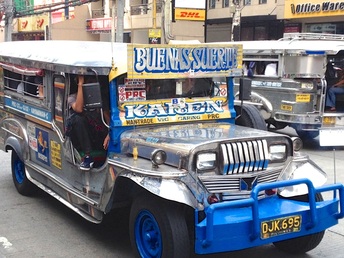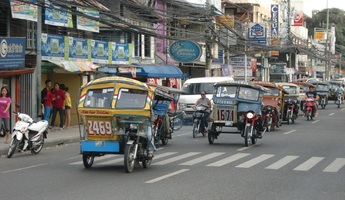| Each city in the Philippines has its own mode of public transportation. In Manila and Cebu City, people rely on jeepneys—sort of open-air vans or short buses that follow designated routes. Manila jeepneys are famous for their brilliant decorations. Dumaguete City, a regional capital of Negros Oriental, is relatively small. There are jeepneys to and from neighboring towns, but within Dumaguete we rely on three-wheel motorcycles with room for extra passengers. There are roughly 2000 licensed tricycles, as they’re called here, that taxi us around the city. |
About a quarter of the tricycles leave out the religious messaging, but paint their family or company name on the tricycle. I’ve managed to find only a handful of tricycles that vary from these two designs. L. Ron Hubbard’s Dianetics has a tricycle emblazoned with its Website (no comment). I love “The Rock” tricycle design and have spotted him a few times. Two tricycles have banners that seem original, if maybe just a little subversive given the context: “The Power of You” and “One World is Enough, a Wise Man Said.” A third says on top, "So What?" and then answers below, "Oh Yeah..." The ellipsis seems crucial here. Another tricycle I’ve spotted twice, but failed to record in a photo, announces itself boldly: “I Don’t Know!” I'm not sure if the driver is trying to throw shade (I hope I'm using that term correctly) on Dumaguete's believers or if the driver is just wryly warning passengers of his geographic limitations. Below the passenger window on the front of the tricycle, a panel reads: “Cheap Ride.”
My all-time favorite Dumaguete tricycle banner was spotted only once a couple weeks ago, and unfortunately, I didn’t capture it on camera. (I’m beginning to suspect this tricycle was a day-tripper from another town.) The tricycle says, very directly, “Sad but True.” Is this a warning to passengers about the ride if they climb aboard? Or maybe he's just making an honest statement that, unfortunately, could apply to too many things in this life.





 RSS Feed
RSS Feed